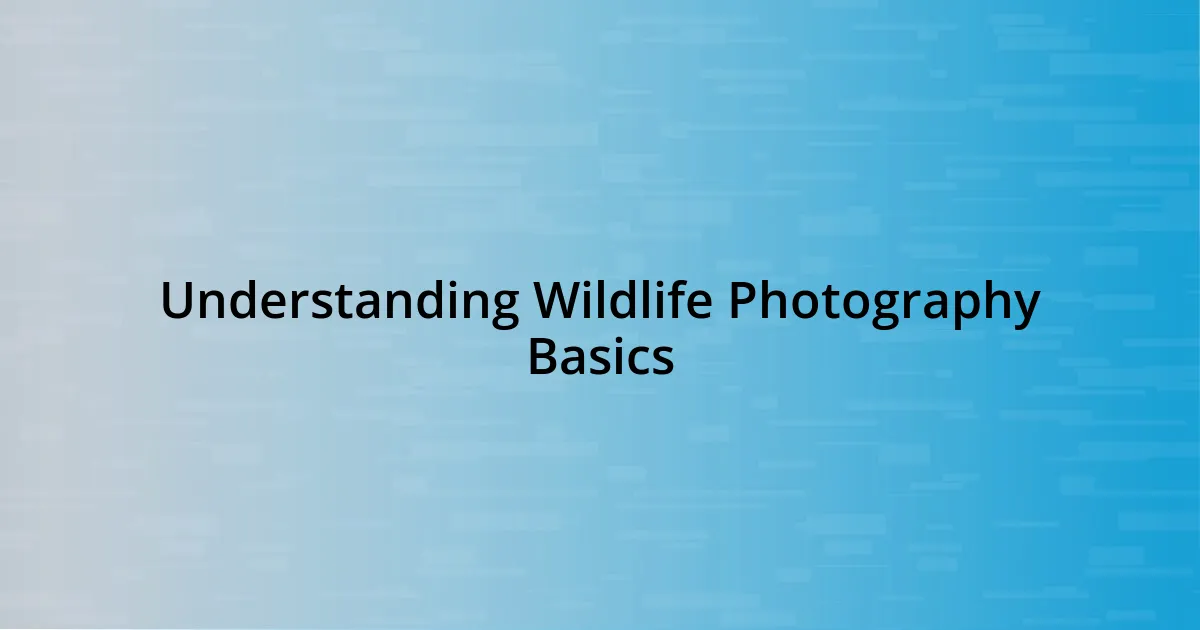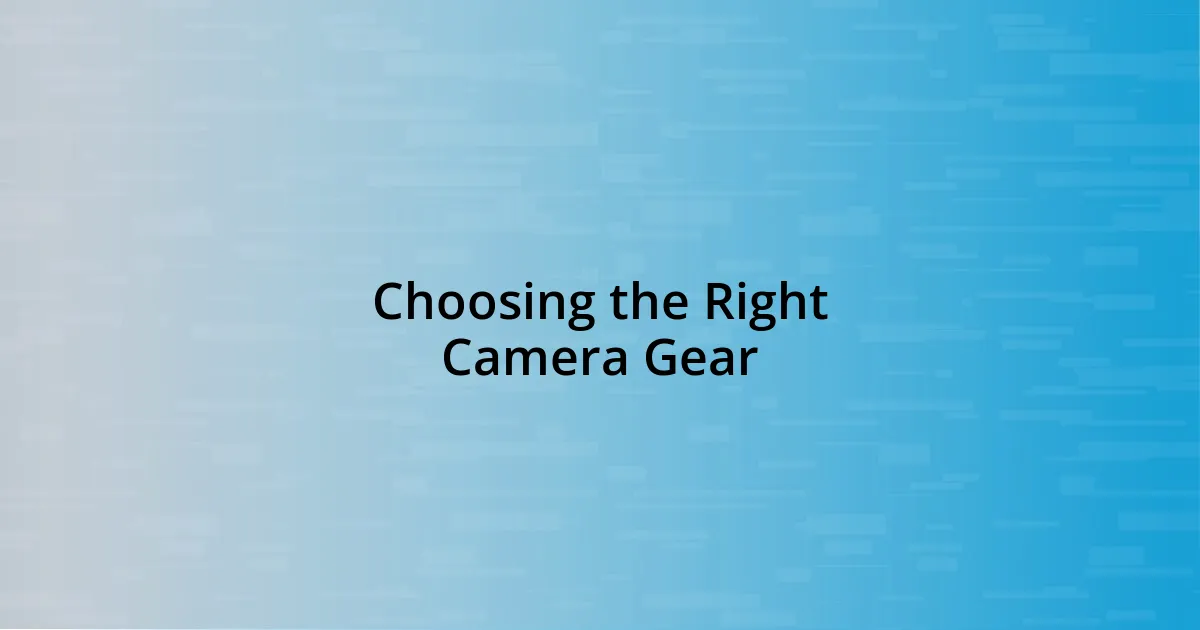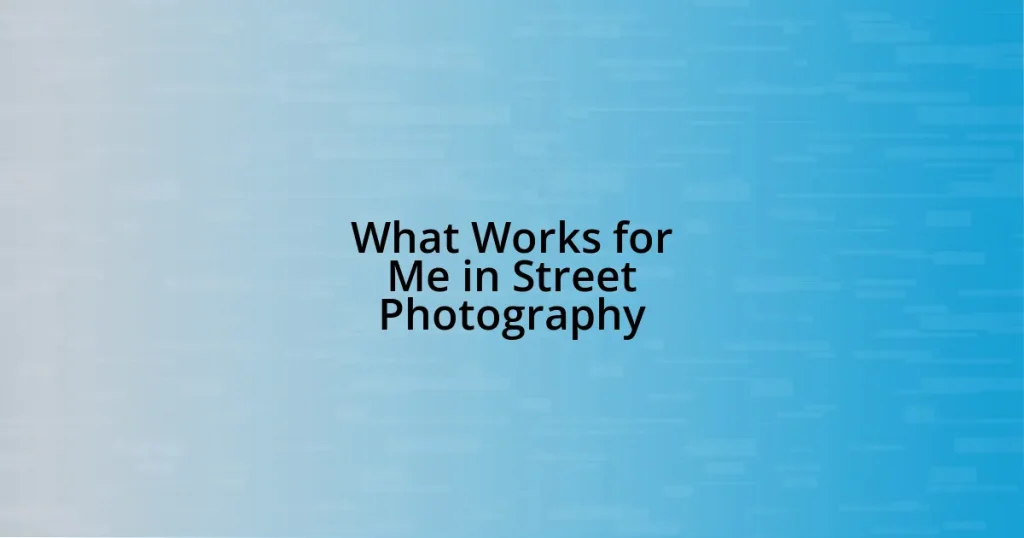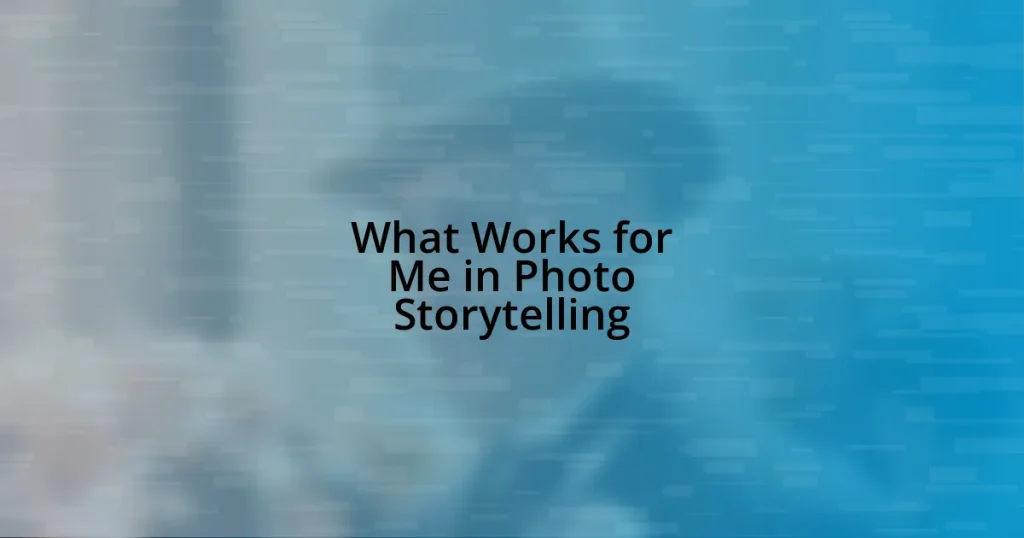Key takeaways:
- Patience and understanding animal behavior are crucial for capturing stunning wildlife photos.
- Invest in quality camera gear, particularly fast telephoto lenses, for better detail and distance while shooting.
- Mastering techniques such as composition, shutter speed, and lighting, especially during golden hours, enhances the quality of wildlife photography.
- Practice ethical photography by respecting wildlife, understanding local laws, and preserving their habitats.

Understanding Wildlife Photography Basics
Understanding wildlife photography basics begins with recognizing the importance of patience. I remember one chilly morning at dawn, waiting motionless in my blind as the world slowly awakened. It hit me then: capturing the perfect shot often requires simply being present and allowing nature to unfold in its own time.
Another key factor is mastering your equipment. When I first started, I felt overwhelmed by all the buttons and settings on my camera. But when I took the time to study the manual and really understand how aperture, shutter speed, and ISO worked together, everything changed. It was like discovering a hidden language that allowed me to communicate effectively with the natural world.
Lastly, it’s essential to learn animal behavior. Knowing when a deer is likely to graze or when a bird will take flight can make all the difference in getting that stunning shot. Have you ever noticed how a slight change in your position can alter an animal’s comfort level? From my experience, a little understanding of their habits not only enhances your photography but also deepens your connection with the wildlife around you.

Choosing the Right Camera Gear
Choosing the right camera gear can feel daunting, but it’s crucial for successful wildlife photography. I remember standing at the edge of a misty forest with my first DSLR, feeling both excited and intimidated. Over time, I realized that investing in quality lenses was more impactful than the body itself. A fast telephoto lens changed everything for me; not only did it allow me to shoot from a distance without disturbing the animals, but it also captured gorgeous, crisp details even in low light.
When selecting gear, consider the following essentials:
- Camera Body: A reliable, durable body that performs well in various weather conditions.
- Lenses: A range of lenses, especially a versatile telephoto lens (like 300mm or 400mm), for capturing distant subjects.
- Tripod/Monopod: Stabilization tools to ensure sharp images, especially with longer exposures.
- Memory Cards: High-speed memory cards for burst shooting—wildlife doesn’t wait around!
- Weather Protection: Gear that’s water-resistant or rain covers to protect your equipment in unpredictable weather.
These choices played a significant role in building my confidence. I vividly recall one day spotting a majestic eagle soaring overhead. Because I had the right lens, I could freeze that moment, feeling both thrill and fulfillment wash over me as I pressed the shutter. It’s these little victories that keep me coming back for more.

Essential Wildlife Photography Techniques
When it comes to wildlife photography, mastering techniques like focusing and composition is vital. I vividly remember a time at a local wildlife park, capturing a family of elephants. I experimented with different angles and realized how an off-center composition drew the viewer’s eye. This technique not only highlighted the elephants’ playful interaction but also created a more engaging story within the frame. Have you ever thought about how the rule of thirds could transform your photos? It’s a simple yet powerful way to arrange elements in your image, making your wildlife shots more dynamic.
Another essential technique is using the right shutter speed to freeze motion, especially in fast-moving animals. I once had the thrill of photographing a cheetah sprinting across the savannah. The rush I felt as I adjusted my settings to capture its speed was exhilarating! The correct shutter speed allowed me to freeze that incredible moment, giving me a photo that felt alive. I encourage you to experiment with different speeds. You might be surprised by how a small change can alter the story your image tells.
Finally, light plays a critical role in wildlife photography. I always aim to shoot during the golden hour—the hour after sunrise and before sunset. On one memorable trip, I caught a group of deer illuminated by soft, warm light. The effect was magical, highlighting their features beautifully and enriching the background colors. Can you imagine how differently that scene would have looked under harsh midday sun? It’s moments like these that remind me of the beauty of timing and nature’s unpredictability.
| Technique | Description |
|---|---|
| Focusing and Composition | Utilizing techniques like rule of thirds creates dynamic imagery. |
| Shutter Speed | Adjusting shutter speed freezes motion, ideal for fast-moving animals. |
| Lighting | Shooting during golden hours enhances the beauty of wildlife photography. |

Mastering Natural Lighting Conditions
There’s something magical about natural lighting that truly transforms wildlife photography. I recall hiking early one foggy morning, the world still waking up around me. As the sun broke through the clouds, it cast a warm glow over the landscape, making the dew-covered grass sparkle. Those moments remind me of the power of light; it can create an atmosphere that brings a photograph to life. Have you ever experienced that moment when the light just feels right? It’s like the universe aligns to gift you a breathtaking scene.
I strive to be mindful of shifting light conditions throughout the day. For instance, I once found myself crouched beside a riverbank, hoping to capture a family of otters playing. It was nearing noon, and the harsh lighting made it challenging to get a good shot. I had to wait, watching them frolic in the water, and I learned patience pays off. When the clouds rolled in later, softening the light, I seized the opportunity. The resulting photos showcased their playful energy, without the glare interfering. It’s a perfect example of how being adaptable to natural lighting can lead to stunning results.
Moreover, understanding the direction of light is vital. I remember a magical encounter with a herd of bison at sunset. As they moved across the horizon, the backlight illuminated their silhouettes, creating a dramatic effect. I instinctively lowered my angle, framing them against a fiery sky. It was like a scene pulled from a dream, and I couldn’t help but feel both excited and grateful as I pressed the shutter. Have you ever captured something that resonated with you deeply? That’s the beauty of wildlife photography; it’s about catching fleeting moments where light and life dance together.

Capturing Wildlife Behavior
Capturing wildlife behavior requires a keen eye and a deep understanding of animal instincts. On one occasion, I found myself quietly observing a pair of red foxes playing in a snow-dusted clearing. I noticed how their playful pounces mirrored those of domestic cats, a familiar yet captivating sight. Have you ever taken a moment to really study your subject? Sometimes, just being patient allows you to witness interactions that reveal the essence of animals, like the trust between a mother and her cubs during a gentle grooming session.
To effectively document these behaviors, I often think about the importance of being inconspicuous. One of my most thrilling experiences involved sitting in a blind near a thriving bird feeder. I watched as a family of squirrels cautiously approached, their nervous glances serving as a reminder of their instinctual wariness. Each twitch and flick of their ears provided a new angle for storytelling in my photographs. I wondered, how can something so small and seemingly mundane feel so significant? It’s moments like these that truly showcase the delicate balance of nature.
Timing, in wildlife photography, can change everything. There’s one particular instance that stands out—when I was fortunate enough to catch a glimpse of a large bull moose during the rutting season. The way he postured and challenged rivals was a spectacle of raw power and passion. As I clicked the shutter, I realized the importance of not just capturing an image, but narrating a story. That’s the heart of wildlife photography: I believe it’s about immersing yourself in the moment, so that every photograph you take breathes life into the incredible behavior unfolding before you. Isn’t it exhilarating to be part of that extraordinary story?

Tips for Ethical Wildlife Photography
Ethical wildlife photography is not just about the image; it’s about respect toward the subjects we’re capturing. I vividly recall a moment when I was photographing a nesting pair of eagles. I kept my distance, knowing that too much intrusion could distress them. Watching them through my lens, I felt a deep sense of responsibility—after all, it’s their home, and I’m just a visitor. Have you ever considered how your presence impacts the wildlife you’re trying to photograph?
I also prioritize understanding the local laws and guidelines for wildlife photography. One time, I almost ventured too close to a mother bear with her cubs but paused to double-check restrictions in the area. That precaution turned out to be vital; it reinforced my belief that following ethical practices not only protects wildlife but also enhances our own experience. I often ask myself, how can one justify a photograph if it compromises the safety and well-being of the creatures involved? It’s a question worth reflecting on, particularly in the pursuit of our art.
Lastly, I’ve learned that leaving the environment as I found it is essential. When visiting sensitive habitats, I make it a point to tread lightly, avoiding areas that could disrupt the natural landscape. I often remember a particular trip to a wetland where, after a day of shooting, I was reminded by the vibrant colors and life around me just how precious these ecosystems are. Isn’t it fulfilling to know that, in preserving these places, we contribute to the future of wildlife photography? Every step we take should reflect our commitment to the land and its inhabitants.
















